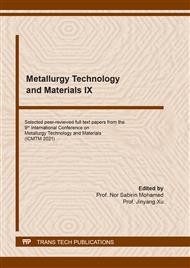[1]
Bello, O. and E. P. Dolberg, et al. (2020). Transformation of academic teaching and research: Development of a highly automated experimental sucker rod pumping unit., Journal of Petroleum Science and Engineering 190: 107087.
DOI: 10.1016/j.petrol.2020.107087
Google Scholar
[2]
Ding, H. and J. F. Xie, et al. (2019). Fracture analysis of a connecting rod for oil pumping unit in China western oilfield., Engineering Failure Analysis 105: 313-320.
DOI: 10.1016/j.engfailanal.2019.07.021
Google Scholar
[3]
Nguyen, T. and Y. Bai, et al. (2011). Mechanical characterization of steel/CFRP double strap joints at elevated temperatures., Composite Structures 93 (6): 1604-1612.
DOI: 10.1016/j.compstruct.2011.01.010
Google Scholar
[4]
Yu, T. and D. Fernando, et al. (2012). Experimental study on CFRP-to-steel bonded interfaces., Composites Part B: Engineering 43 (5): 2279-2289.
DOI: 10.1016/j.compositesb.2012.01.024
Google Scholar
[5]
Wu, C. and X. L. Zhao, et al. (2013). Effect of fatigue loading on the bond behaviour between UHM CFRP plates and steel plates., Composites Part B: Engineering 50: 344-353.
DOI: 10.1016/j.compositesb.2013.02.040
Google Scholar
[6]
Li, C. and G. Xian, et al. (2019). Tension-tension fatigue performance of a large-diameter pultruded carbon/glass hybrid rod., International Journal of Fatigue 120: 141-149.
DOI: 10.1016/j.ijfatigue.2018.11.007
Google Scholar
[7]
Al-Mosawe, A. and R. Al-Mahaidi, et al. (2015). Effect of CFRP properties, on the bond characteristics between steel and CFRP laminate under quasi-static loading., Construction and Building Materials 98: 489-501.
DOI: 10.1016/j.conbuildmat.2015.08.130
Google Scholar
[8]
He, J. and G. Xian, et al. (2020). Effect of moderately elevated temperatures on bond behaviour of CFRP-to-steel bonded joints using different adhesives., Construction and Building Materials 241: 118057.
DOI: 10.1016/j.conbuildmat.2020.118057
Google Scholar
[9]
Biscaia, H. C. and C. Chastre, et al. (2017). Analytical model with uncoupled adhesion laws for the bond failure prediction of curved FRP-concrete joints subjected to temperature., Theoretical and Applied Fracture Mechanics 89: 63-78.
DOI: 10.1016/j.tafmec.2017.01.008
Google Scholar
[10]
Dai, T. and Y. Yang, et al. (2019). Interfacial stress analysis of a CFRR-metal adhesively bonded joint with/without defect under hygrothermal environment., Applied Mathematical Modelling 67: 357-377.
DOI: 10.1016/j.apm.2018.10.032
Google Scholar
[11]
Yin, X. L. Research on Durability and Life Evaluation Method of CFRP/GFRP Composite Sucker Rod under Complex Environments [D]. China university of petroleum (Huadong), (2020).
Google Scholar


